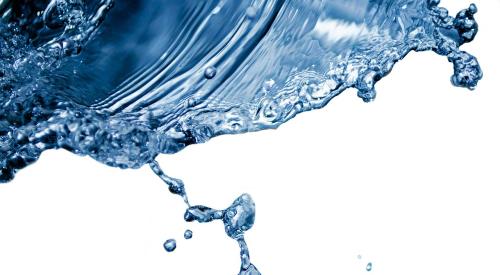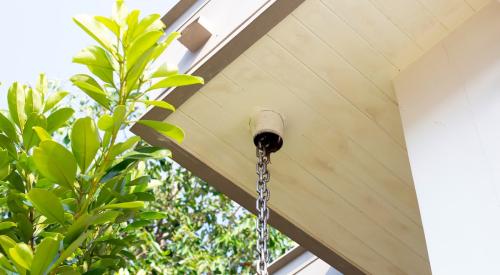|
Mother Nature is ironic. As one part of the country was being saturated by rain and flood waters, the rest of the country was suffering one of the longest droughts on record. Lush lawns baked to a golden straw; blooming buds dried as quickly as they grew. Home builders and owners alike were desperate to conserve any water Mother Nature delivered.
Enter rainwater harvesting.
Profiting from RainRainwater harvesting is an easy and cost-effective way to conserve water. How? Because it allows homeowners to water their lawns and gardens with collected rainwater instead of using water from a private well or municipal reserves.
Most rainwater collection systems include five components:
- A catchment area
- A conveyance system
- Roof washing
- A holding system
- Distribution
The greatest benefit rainwater harvesting offers builders is increased ability to get building permits in areas that have water-related moratoriums. In areas throughout the desert Southwest, for example, it is very difficult to get the necessary permits without including substantial water-saving measures in the project.
 |
"For example, Cochise County, Ariz., requires all builders to go through a project approval process," Kinkade-Levario says. "If builders can show they are not using more water than a standard subdivision on well water, they can get a density bonus to allow additional units. These standards may also require that low-flow fixtures and native landscapes are installed to meet the total water usage reductions."
Builders may also benefit from reduced stormwater management costs.
"Rainwater harvesting is a great way to control a lot of on-site drainage," says Mike Chapman, a home builder in Santa Fe, N.M. "We don't have to deal with runoff from roof water because it gets siphoned-off into the holding tank."
By lowering the amount of peak runoff, a smaller, and potentially less costly, stormwater management system can be put in place.
Although Chapman is a fan of these cost savings, he installs rainwater catchment systems because of the high consumer demand. Eighty percent of his customers upgrade to a rainwater harvesting system.
 |
"We offer these systems completely in response to the marketplace," he says. "We are in an area where water is a huge issue. And we can offer our customers the option of increasing the amount of water they can use for landscaping at an affordable price."Success in Simplicity
Chapman typically installs a 1200-gallon cistern with downspouts plumbed into the tank. The water is removed from the tank by a submersible pump. Homeowners can hook a hose up to the tank just like a regular faucet and water their lawn or garden or wash their car. The installed cost varies between $3000–$4000, based on the terrain and layout of the roof.
This is Chapman's least expensive option, and one that appeals to those customers who are simply going to water trees and plants with it.
"Most builders ought to keep it simple," he says. "When you complicate how you feed water into the sprinkler system, you have more to maintain. My recommendation is the simpler the better."
Maximize the BenefitsRainwater harvesting is popular in the desert Southwest, where there is limited rainfall and droughts are a serious issue. In these conditions, it is easy for builders and homeowners to see why collecting and storing the rainwater makes sense. But builders in areas with average and even above-average rainfall are including rainwater collection systems in their projects.
Dana Bres, a senior research engineer for the Partnership for Advancing Technology in Housing explains that rainwater harvesting is very practical in climates where rain is more frequent and is evenly dispersed throughout the year. Harvesting is practical, Bres says, because less water needs to be stored at any one time, lowering installation costs. Because the most expensive component of rainwater harvesting is buying and installing the cistern, reducing the amount of water the homeowner needs to store will reduce the size of the cistern and the size of the hole that the cistern is buried in. This lowers installation costs, which makes it easier to sell to customers.
Design and InstallationDesigning a system with appropriate storage is one of the most important aspects of installing a rainwater catchment system, Bres says. Installing a cistern that is too small minimizes the benefits, while installing a cistern that is too large is needlessly expensive.
"This is where the 80-20 rule comes into place," he says. "It takes 20 percent of the effort and money to get 80 percent of the water, and 80 percent of the money to get the remaining 20 percent of the rainwater. So, it may be appropriate for the builder to size the system to be successful 80 percent of the time."
How can a builder determine what size cistern to install? The general rule of thumb is that every inch of rain will produce about 623 gallons of water for every 1000 square feet of roof area. Based on the rainfall for the local area and the desired use of the water, you can approximate how much water needs to be stored.
Sell this upgrade to your customersRainwater harvesting allows homeowners to keep their landscape green while minimizing their water bills or the demand on their well. The following list demonstrates benefits that builders can highlight when speaking with homebuyers:
- Reduced water and sewer costs. In most urban communities, sewer costs are based on water usage. By capturing rainwater and reducing water purchased for landscaping, homeowners can also save money on their sewer bills. In Arlington, Va., for example, homeowners will save about $3 on water fees and $4 on sewer fees for every 1000 gallons of water captured and used for landscaping. This can save the average homeowner $600 per year.
- Extra water. In many drought-stricken areas, homeowners are only allowed to water their plants once or twice a week, if at all. With their own rainwater reserves, they can water more frequently.
- Healthier lawns and plants. Plants respond better to rainwater than tap water, Kinkade-Levario says. Rainwater is naturally soft water without chlorine, fluoride, and other chemicals that are harmful to the environment.
|












